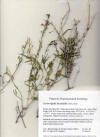|
Carlowrightia linearifolia |
|
|
Adesina S. K., O. Idowu, A. O. Ogundaini, H. Oladimeji, T. A. Olugbade, G. O. Onawunmi and M. Pais. 2000. Antimicrobial constituents of the leaves of Acalypha wilkesiana and Acalypha hispida. Phytother. Res. 14(5): 371374. An activity directed fractionation of a 50% aqueous ethanol extract of A. wilkesiana and A. hispida leaves resulted in the isolation of gallic acid, corilagin and geraniin as the compounds responsible for the observed antimicrobial activity. Quercetin 3-O-rutinoside and kaempferol 3-O-rutinoside were also isolated from the inactive fraction of A. hispida. The structures were established by permethylation, 2D - NMR ((1)H and (13)C) and MS data. Bόssing A., G. M. Stein, I. Herterich-Akinpelu and U. Pfόller. 1999. Apoptosis-associated generation of reactive oxygen intermediates and release of pro-inflammatory cytokines in human lymphocytes and granulocytes by extracts from the seeds of Acalypha wilkesiana. J. Ethnopharmacol. 66(3): 301309. Seeds from Acalypha wilkesiana (Euphorbiaceae) are an essential component of a complex plant mixture used empirically by traditional healers in Southwest Nigeria to treat breast tumours and inflammation. To investigate their biological properties, we incubated human lymphocytes and granulocytes with aqueous and ethanolic extracts of A. wilkesiana seeds (AWS). In lymphocytes, we observed an induction of apoptosis and generation of reactive oxygen intermediates (ROI), as measured by the oxidation of hydroethidine, within 2 h, while in granulocytes, an aqueous seed extract induced the oxidative burst and enhanced phagocytosis of Escherichia coli within 10-20 min. In the supernatants of 72-h cultured lymphocytes, AWS induced the release of the pro-inflammatory cytokines tumour necrosis factor-alpha and interleukin-6, and also T-cell-associated cytokines interleukin-5 and interferon-gamma. These preliminary results encourage further investigations of this drug with both cytotoxic and immunomodulating properties. Gutierrez-Lugo M. T., M. P. Singh, W. M. Maiese and B. N. Timmermann. 2002. New antimicrobial cycloartane triterpenes from Acalypha communis. J. Nat. Prod. 65(6): 872875. Three new cycloartane-type triterpenes, 16 alpha-hydroxymollic (1), 15 alpha-hydroxymollic (2), and 7 beta,16 beta-dihydroxy-1,23-dideoxyjessic acids (3), were isolated from the aerial parts of Acalypha communis. The structures of the novel triterpenes were determined by spectroscopic methods as well as chemical derivatization. These compounds were tested for their antimicrobial activity against Gram-positive and -negative bacteria. Compounds 1-3 exhibited moderate antimicrobial activity (MIC 8, 32, 8 microg/mL, respectively) against vancomycin-resistant enterococci. In addition, compound 1 was found to be active against methicillin-resistant staphylococci. In contrast, compounds 1-3 were poorly active against Gram-negative bacteria. Compound 3 was tested in an in vivo model; it did not provide protection to mice infected with Staphylococcus aureus. Jekayinfa A. O., A. O. George and K. T. Jaiyeoba. 1997. Acalypha wilkesiana: preliminary in vitro microbiological and clinical trial on dermatitis. Afr J Health Sci. 4(1): 3942. Acalypha wilkesiana is a common hedging plant in West Africa. Water extract of the red/brown varieties, the Red Acalypha has been used for decades by the local inhabitants for treating skin problems. The water extract of A. wilkesiana was subjected to a clinico-laboratory study to assess its efficacy i.e. ability to clear standard organisms in agar plates and to stop symptoms and clear skin lesions of eczema cases in a 3-week study period. The extract showed significant antibacterial and antifungal properties in vitro and was found to be reasonably useful in the treatment of eczema. No allergy or irritation was documented in the cases used for the study. In a depressed economy as found in most developing countries of Africa, medicinal plants like Acalypha wilkesiana could be used as a cheap and readily available sources of skin medication. More work is required to determine the active ingredients in the crude extract. Kambara H., T. Yamada, M. Tsujioka, S. Matsunaga, R. Tanaka, H. I. Ali, C. Wiart, M. Yusof, H. Hassan, A. Hanifah, Z. M. Fauzi, N. H. Mazlan, M. Jay, M. Kunishima and E. Akaho. 2006. A study on medicinal plants from Malaysia focused on Acalypha siamensis Oliv. ex Gage. isolation and structure of a new tetraterpene, acalyphaser A. Chem. Biodivers. 3(12):13011306. As a part of our chemical studies on Malaysian medicinal plants, five Malaysian plant species were evaluated by cytotoxicity assays using P388 murine leukemia cells. Since Acalypha siamensis exhibited the strongest growth inhibition, its constituents were studied as the object of search for bioactive materials. A novel tetraterpene, acalyphaser A (1), was isolated in the course of the purification. Its structure was elucidated on the basis of 1D- and 2D-NMR techniques, and mass spectrometry. Oyelami O. A., O. Onayemi, F. A. Oladimeji, A. O. Ogundaini, T. A. Olugbade and G. O. Onawunmi. 2003. Clinical evaluation of Acalypha ointment in the treatment of superficial fungal skin diseases. Phytother. Res. 17(5): 555557. In an open non-comparative study to evaluate the efficacy and safety of Acalypha wilkesiana ointment in superficial fungal skin diseases, 32 Nigerian patients with clinical and mycological evidence of superficial mycoses were recruited. Twelve patients defaulted and were lost to follow up, while one patient withdrew because of intolerable excoriation at the site of the lesion. Of the 19 patients that completed the trial, clinical cure was achieved in 73.3% of the patients. The ointment was very efficacious in the treatment of Tinea pedis, Pityriasis versicolor and Candida intetrigo where the cure rate was 100% in each condition. It is recommended that Acalypha ointment can be used for the treatment of these superficial mycoses. |
|
